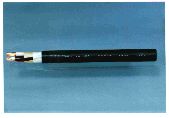1999 The former Hitachi Cable News Release
Information (including product prices, product specifications, details of services, launch dates, inquiry information, and URLs) contained in this news release is current as of the date of the press release but is subject to change without notice. Please note that details may differ from those effective on the search date.
Introducing the recycling considerate 'Eco-Green'(R) (environmentally friendly) Cable, electrical power use cable & its use of the newly developed heat resistant non-cross linked polyethylene
Recently we have developed a recyclable heat resistant polyethylene insulating low pressure power cable to add to our environmentally friendly 'Eco-Green (R) Power Cable Series'.
Various environmentally friendly power cables have been developed to counteract harmful gas production when power cable is discarded or incinerated; but in the case of electrical power cable, in order to correspond to the heat produced by the electrical flow, the insulating body has to have high heat resistance reliability & non-recyclable cross linked polyethylene has been used.
However, we thought we should act now & consider the depletion in the future of natural oil resources, & the move towards a cyclic society in the 21st century, & that the development of the manufacturing technology for a recyclable insulating material was an important point; so we promoted the development of a new insulating material to replace the cross linked polyethylene.
A successful result was reached with the heat resistant non-cross linked polyethylene which opened up the possibilities of recycling.
Polyethylene is well suited as an insulation material for electric power cable with superior electrical properties, but the usual polyethylene lacks reliability for heat resistance. As molecules are not combined with other molecules when the temperature becomes hot a melt flow (Thermo-plasticity) occurs ( a condition which becomes similar to that of candle wax melting).
On the other hand, in cross linked polyethylene, molecules are caused to chemically combine with other molecules (chemical cross linking is usually known in units of 'cross link'), in an improved 3 dimensional network construction so even if the temperature becomes hot a melt flow does not occur. With this improvement the permissible temperature for the conductor in cross linked polyethylene can be a high 90C, as against the 75C permissible conductor temperature of polyethylene. However, regarding the recycling of used cable; because cross linked polyethylene does not have a melt flow even at high temperatures, the material can only be used after either crushing or the thermal decomposition of the polyolefin to an oil as thermally recycled fuel but, can not be used again as actual recycled material.
Meanwhile, the manufacturing technology of polyethylene is quickly evolving & it has become possible to control the temperature of the molecular construction. The non-cross linked polyethylene that we have developed from amidst these new generation polyethylenes is principally suitable for electrical power cable insulation. Furthermore with our original combination & processing technology the thermo-plasticity remains as it is, meaning that we can use our material instead of cross linked polyethylene, for use as an insulating body material.
It has been confirmed that the recycling considerate 'Eco-Green (R) (environmentally friendly) cable' for use in low pressure power cables that we have recently developed, is fully compliant with all demands as stipulated by JIS standard regulations.
